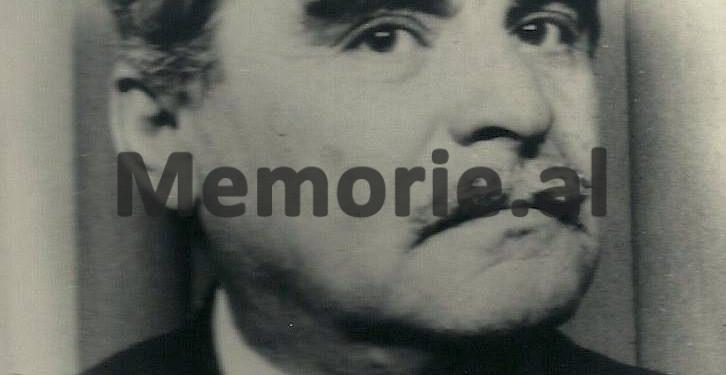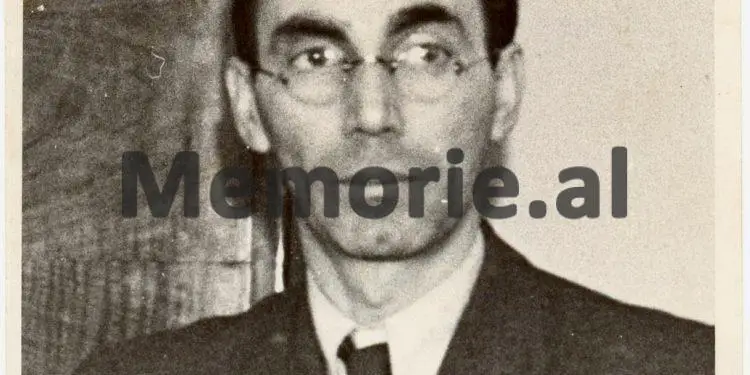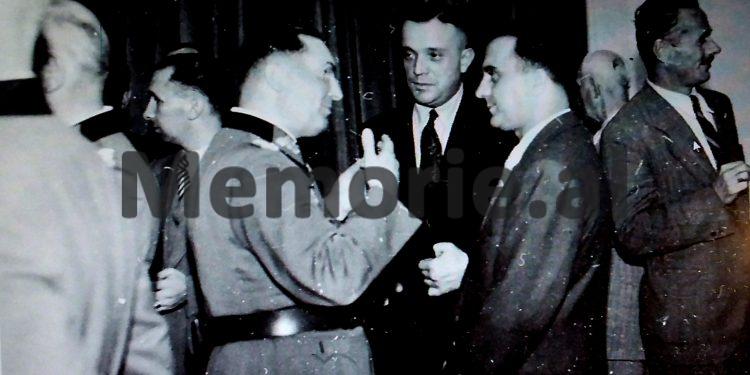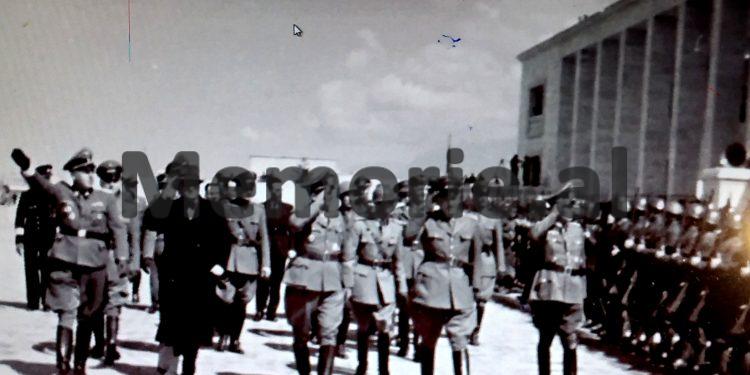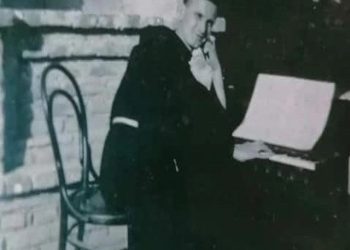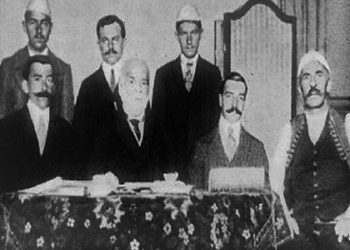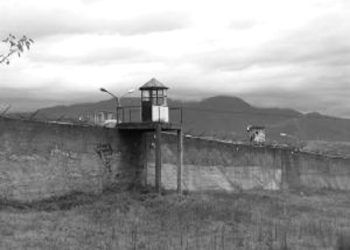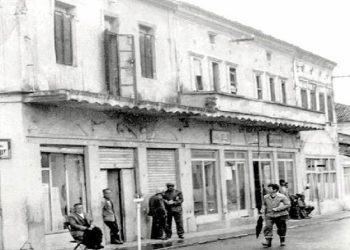By Astrit Jegeni
The first part
-The event of February 4, 1944, in the perspective of the “Bashkimi” newspaper, of the testimonies of Xhefer Deva’s personal secretary and his colleague, Minister Musa Gjylbegu, as well as unknown Albanian and German archival documents!-
Memorie.al/ Continuous mass murders committed under the power of hatred and revenge carry endless pain in time and the feeling of revenge and retribution never fade. Unfortunately, politics has manipulated these black dates for its unreasonable and vulgar interests. In these 50-60 years, we Albanians have several such examples of massive murders, of the “punitive” type, carried out intense political situations, such as: “February 4, 1944”, “The murders of Shefqet Peçi in the Kukës River”, in in 1944, “The murders of Shefqet Peçi in the Kukës River”, in 1944, “The murders in Gurëz of Kurbini for Rexhe Deli”, in 1946, “The murders in Mirdita for Bardhok Biba”, in 1949, “The embassy bomb Soviet” in 1951, etc.
By making public the causes, the motives, the characters who participated in these murders, both the victims and the killers, we believe that we raise people’s awareness and try to give them the mindset that these mass murders, after all, are an expression of a civilization that has no value and needs to review its own values. By explaining these events, away from the banal pragmatism of politics, I hope that, knowing the events as they really happened, we will make our civilization aware of logic of action, more reasonable and more controllable. With this in mind, we are giving a modest study of the killings of February 4, 1944.
“February 4”, according to “Bashkimi” newspaper, February 1945
In order for our modest study to get an answer as close as possible to the truth of this event, we are quoting excerpts from the newspaper “Bashkimi” which is in a way an official investigation into the murders of February 4, 1944, and which we think is the only investigation that was done by the communist regime, for this murder. From the contradictions about the truths that the first part of the study has, with the second part, the reader will have the opportunity to draw the logical and right conclusions about the murders of February 4, 1944.
I emphasize that the difference between the first part of our study and the second part is that the second part has a normal investigation and has our conviction, while the first part is a journalistic investigation and as such contains in its core dose of disbelief for this variant, in some important elements of this event.
In the “Bashkimi” newspaper of February 3-4-5, 1945, a rich piece of information is written about the commemoration of “February 4, 1944” referred to by communist history as: “The Massacre of February 4”. We are quoting parts from this newspaper, to enlighten our minds about the truth of this day of murders.
The newspaper “Bashkimi” on 3.2.1945, on the first page, at the bottom right, in bold writing, gives this announcement, as follows. “Families, relatives, or friends are invited, and every citizen who knows the names of the martyrs of February 4, 1944, to inform them within today, at the National Council of the City of Tirana”.
This invitation of the newspaper to the citizens of Tirana, to provide data, is an indication that the communist government did not know anything accurate about this event, simply until the day it made the announcement, it propagated this event under the emotional and shocking effects, that this day has left for the citizens of the capital, but who actually did not know the number of those killed, nor the causes, nor the names of the victims of this day.
Simply, it was known that mass murders were committed in Tirana, unprecedentedly until that day of the civil war that took place in Albania, by the opposing wing of the communists. In a long statement, with the title “for February 4”, published in the newspaper “Bashkimi”, signed by the Central Committee of the Albanian Communist Party, there were many words about the memory of the killed and about the revenge that the communists would take, where it was written that about 80 people were killed and in this statement, only the names of Todi Shkurti, Vangjel Capo, Hasan Çeliku and Mihal Koçi are given.
Other names, this statement of the most powerful organ of Albania at that time, (such as the newspaper “Bashkimi”) does not mention. In the Albanian press of the time, it was constantly written about this murder of February 4, with the figures of 104 or 80 people. Figures which we can prove are documented, but not even the communist regime of Enver Hoxha and his successor, Ramiz Alia, has ever proven them throughout his 45 years of power.
Yes, in this newspaper (“Bashkimi”, dt. 3-4-5 February 1945), there are several articles about this event written by Sejfulla Malëshova, but in the field of emotions and experiences, there is no exact figure for the killed or their names.
Another very emotional article, about the memory of “February 4” signed by Demo Koti (we believe it will be a pseudonym), with the title: “Who is missing, who was killed”, these names are given as follows of those killed on February 4 1944. “Fadil Rada, Xhemal Sojli, Davi Cohen, Sitki Çiço, Petro Prifti, Vasil Muzina, Gjergji Marangosi, Haki Huta, Dr. Pano, Emurdha Korra, Mihal Jani Koça, Rag. Ravesi, Sulejman Vrapi, Sokrat Tako, Ramiz Treni, Vangjel Cako, Harito Harito, Ali Visha, Mina Toma, Todi Shkurti, Gjergj Legisi, Islam Halla, Shyqëri Grablleshi, Hasan Rexhepi and Dhimitër Thoma”.
In this list written by “Bashkimi” newspaper, there are a total of 25 people killed and not determined as to nationality. In a prominent place in the newspaper “Bashkimi” dated 4.2.1945, a list was published which is the only document that sheds light on the names of those killed, which we think has credibility. We are reproducing the article as follows:
Bashkimi Newspaper: “The Martyrs of February 4, 1944”
Xhemal Sojli, Sitki Çiço, Vasil Muzina, Haki Huta, Maliq Huta, Mihal Jani Koço, Sulejman Vrapi, Prof. Ramiz Treni, Vangjel Capo, Harito Harito, Ali Visha, Mina Thoma, Todi Shkurti, Fadil Rada, Gjergj Legisi, Italian unidentified, Islam Alla, Hasan Rexhep Çeliku, Emurlla Kora, Sokrat Tako, Ragioner Ravesi (Italian), Jorgji Marangosi (Malaysian) executed and killed at the bridge of Lana, four unidentified workers, in front of ‘Sahat’, the Italian executed of Kodra e Quqe, unidentified.
Three Montenegrins released from prison and executed in Kodra e Quqe on February 4, David Cohen (Yugoslav citizen), Dr. Stefan Pano, two unidentified workers (killed in front of Met Fira mosque), Petro Priest, Three killed in Pisha street and unidentified, Dhimitër Thoma, Shyqri Grëblleshi, Vicenzo Apel and another unidentified. Another unidentified person killed in Rr. of Dibra in front of the Dabërdak store. “Another unidentified person, killed in front of the E’them Bey mosque”. The writing has no author.
From the propagandized materials for “February 4” until today, only these names have been declared in the Albanian press. I think that this is the only written material that we have that can be taken seriously with this event and that tries to give the truth in the form of a list of names that were killed on this day. In this article, the names of all the 44 killed have been given, which we have listed as follows.
23 people have their own names and are of Albanian nationality.
2 people, their names and are of Italian nationality.
2 people, of unidentified Italian nationality
1 person of Montenegrin nationality with his name.
3 people of unidentified Montenegrin nationality.
1 person of Yugoslav nationality with his name.
6 people identified as “Worker”
6 people killed, but not identified
This list, which was published in the “Bashkimi” newspaper, leaves room for many conjectures about its veracity, because it is the product of a journalist and not the professional work of a competent body. And to argue this, we are giving you another article from the same newspaper which, in a way, is an indication of the unprofessionalism of the author of this event.
An article was published in the newspaper “Bashkimi” on Friday 9.2.1945 (on page 3 on the upper right side) with the title – “2 heroes, martyrs of February 4”.
We are quoting parts of this article – “…A long time ago, on February 9, 1944, Ali Visha and Lake Sula died under torture at the hands of the people’s executioners. Arrested on the night of February 4, they were taken to the prison near the Gymnasium and on the night of February 9, from 11:30, they were interrogated at the Ministry of the Interior”.
In this article, it turns out that Ali Visha was not killed on February 4, but on February 9. Reading these documentary materials about the murders of “February 4, 1944”, which have a conflict not in the event, which is indisputable, but in the motive and the number of those killed, I believe that I have given an explanation close to the truth of this day of war, which has been very emotionally propagated by the historiography and propaganda of the communist regime, for nearly half a century in a row.
The document with the phonogram in the newspaper “Bashkimi”
And in this newspaper, that is, “Bashkimi”, dated February 9, 1945, this phonogram was published as follows.
Hand Phonogram State Prosecutor’s Office
No. 271. Dt. 28.2.1944 Internal Circle Command
Tirana
The patrol informs us that in the “Ali Pash Parga” Street (Kusi Street) in the region of this command area, 4 unidentified people have been found dead. We are investigating the manner of the murder. The conclusion will be announced later.
Area Commander
Police “Dajti”
N/Lieutenant, Mero Bado
Part of the report from the newspaper “Bashkimi” dt. 28. 2. 1945
About this event, in the newspaper “Bashkimi” of that date, this report was written, as follows.
“After February 4, February 28, 1944, crimes after crimes, massacres after massacres. At dawn, 4 corpses were found on the street of “Kusi”. They were the bodies of Trojan Pekmez, Skënder Kosturi, Gjergj Frashër and Viktor Gjokrec…!
German archival documents for the event of February 4, 1944
It was in the interest of this article to study the German documentation of the War, for this period of time in order to provide as complete a panorama of this event as possible. German documents of this period describe this event as a normal occurrence in a war situation with a dry and precise description.
The Special Delegate for the Southeast,
Neubacher
Ministry of Foreign Affairs
Belgrade Encrypted Telegram, February 17, 1944
No. 358
Special delegate for the Southeast
Albania
Even for the means of information
The situation in Albania can still be considered favorable. The destruction of communist gangs continues even further.
In the city of Tirana itself, with rude cleaning actions by the national forces, the communist party apparatus was destroyed.
The government is gaining space, the formation of the Police and the Gendarmerie is being implemented, with which the further consolidation is thickening. Memorie.al
Neubacher
(Documents of German Institutions for Albanian History 1941-1944, Page 187. Dr. Hakif Bajrami, Kosovo).
The next issue follows







